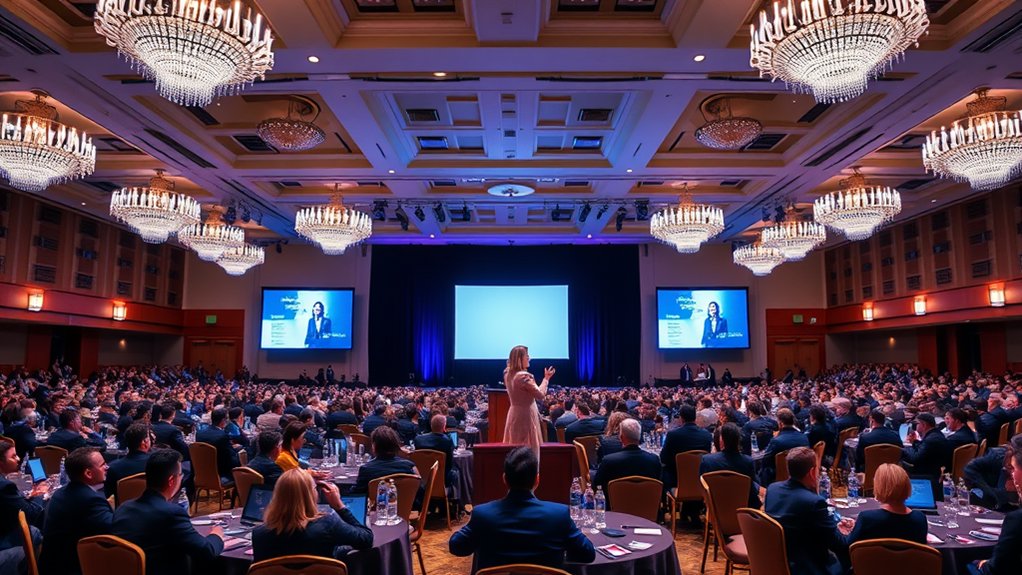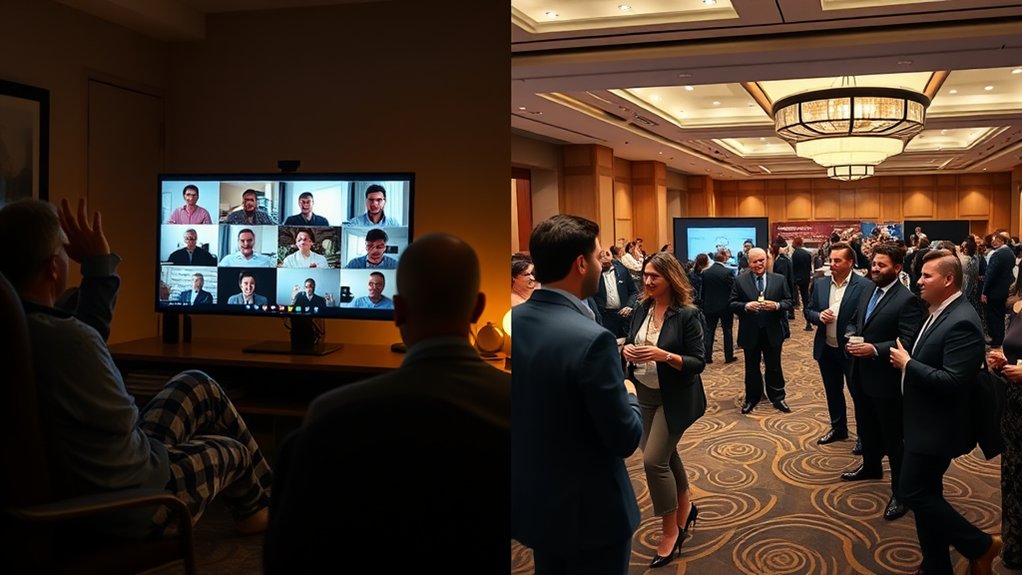
Professional conferences represent a cornerstone of modern knowledge exchange and career development. These structured gatherings bring together experts, practitioners, and enthusiasts from specific fields to share insights, research findings, and industry trends. While traditional in-person events remain valuable, the landscape of professional conferences continues to evolve with technological advances and changing global circumstances. Understanding how to navigate and maximize these opportunities has become increasingly critical for career advancement and professional growth.
Key Takeaways
- Conferences are professional gatherings that include academic presentations, industry discussions, trade shows, workshops, and virtual events for knowledge sharing.
- Attendees gain networking opportunities, professional development, continuing education credits, and exposure to industry trends and innovations.
- Different conference types serve specific purposes, from research presentations at academic conferences to product showcases at trade expos.
- Successful conference participation requires strategic planning, including session selection, networking goals, and adequate buffer time between events.
- Digital tools and post-conference follow-up strategies help maximize the value of conference attendance through organized networking and knowledge retention.
Types of Professional Conferences

Professional conferences come in several distinct formats, each serving different organizational needs and objectives. Academic conferences focus on research presentation and scholarly exchange, while industry symposiums bring together business leaders to discuss market trends and challenges. Trade expos showcase products and services, providing opportunities for vendors and buyers to connect directly.
Professional workshops emphasize skill development and hands-on learning, whereas virtual summits enable global participation through digital platforms. Networking forums facilitate relationship-building and collaboration among professionals, while innovation showcases spotlight emerging technologies and breakthrough solutions. Technical congresses address specific scientific or engineering disciplines, leadership seminars concentrate on management development, and community meetups foster local professional connections in informal settings. Each format uniquely contributes to professional development, knowledge sharing, and industry advancement.
Benefits of Conference Attendance
Professional conferences provide invaluable opportunities for career advancement through workshops, seminars, and specialized training sessions. Attendees can establish meaningful industry connections by networking with peers, experts, and potential collaborators during formal and informal conference activities. These gatherings serve as dynamic platforms for knowledge exchange, allowing participants to learn about emerging trends, share research findings, and gain fresh perspectives from diverse professionals in their field.
Professional Development Opportunities
Attending professional conferences provides numerous career advancement and learning opportunities for participants across all industries and fields. Workshop opportunities and certification programs enable attendees to expand their skillsets, earn credentials, and stay current with industry trends. Through structured learning sessions, professionals can develop expertise in specialized areas while networking with industry leaders.
| Development Type | Key Benefits | Typical Duration |
|---|---|---|
| Workshops | Hands-on learning | 2-4 hours |
| Certification | Industry credentials | 1-2 days |
| Seminars | Knowledge updates | 1-3 hours |
| Training Sessions | Skill enhancement | 4-8 hours |
These professional development activities often include interactive components, practical exercises, and assessments that validate learning outcomes. Many conferences offer continuing education credits, which are valuable for maintaining professional licenses and certifications.
Building Industry Connections
Beyond structured learning opportunities, conferences serve as dynamic hubs for building meaningful industry connections. Attendees engage with peers, industry leaders, and potential collaborators through networking sessions, roundtable discussions, and social events. These interactions often lead to mentor relationships that can shape professional trajectories and open doors to new opportunities.
Conference environments facilitate organic conversations that frequently evolve into collaborative projects between organizations and individuals who might not otherwise connect. Informal discussions during coffee breaks, lunch sessions, and evening receptions allow professionals to share challenges, exchange solutions, and identify mutual interests. The face-to-face nature of conference networking creates stronger bonds than digital connections alone, fostering a community of professionals who can support each other's growth and success in the industry.
Knowledge Exchange Platform
Industry conferences serve as essential knowledge exchange platforms where participants gain exposure to cutting-edge research, emerging trends, and innovative solutions. These events facilitate knowledge sharing through presentations, workshops, and interactive sessions, enabling collaborative learning among industry professionals.
| Learning Format | Benefits | Outcomes |
|---|---|---|
| Presentations | Latest Research | Updated Knowledge |
| Workshops | Hands-on Experience | Practical Skills |
| Panel Discussions | Expert Insights | Industry Perspective |
| Networking Sessions | Peer Learning | Best Practices |
Attendees benefit from diverse learning opportunities, ranging from formal presentations to informal discussions. The multi-format approach guarantees thorough understanding of industry developments. Conference participants can immediately apply acquired knowledge to their professional roles, making these platforms invaluable for professional development and organizational growth. The structured environment promotes focused learning while allowing flexibility for spontaneous knowledge exchange among peers.
Strategic Networking at Events

Strategic networking at professional conferences requires a purposeful approach that extends beyond casual conversations. Effective networking strategies include identifying key attendees beforehand, preparing relevant talking points, and setting specific relationship building goals for each event. Attendees should focus on creating meaningful connections rather than collecting business cards.
Successful networking at conferences involves active listening, asking insightful questions, and following up with contacts after the event. Professionals can maximize their networking opportunities by attending specialized sessions, participating in workshop discussions, and joining social activities where informal interactions occur naturally. The key is to maintain authenticity while demonstrating genuine interest in others' work and experiences. Digital tools and social media platforms can help sustain these professional relationships between conference meetings.
Planning Your Conference Schedule
Conference attendees maximize their experience by carefully prioritizing must-see keynote speakers and breakout sessions that align with their objectives. Building buffer zones between scheduled events prevents rushing and allows for spontaneous conversations with fellow participants. Setting specific networking targets for each conference day helps professionals maintain focus while creating meaningful industry connections.
Prioritize Key Speaker Sessions
When planning a conference schedule, identifying and prioritizing key speaker sessions stands as one of the most essential steps. Attendees should review speaker profiles and select presentations that align with their professional objectives and the conference's key themes. This strategic approach guarantees maximum value from the event.
Evaluating speaker credentials, expertise, and past speaker engagement helps determine which sessions will provide the most relevant insights. Attendees should consider creating a ranked list of must-attend presentations, accounting for potential schedule conflicts. It's advisable to include both industry leaders and emerging voices in the selected lineup. When sessions overlap, researching whether recordings will be available afterward can help in making scheduling decisions. Building in buffer time between priority sessions assures attendees can arrive punctually and secure suitable seating.
Create Time Buffer Zones
Building time buffers into a conference schedule helps attendees navigate the event more effectively while reducing stress and potential conflicts. Strategic placement of buffer time between sessions allows for unexpected situations and creates schedule flexibility when needed.
Key benefits of incorporating buffer zones:
- Provides buffer time between sessions for note-taking, networking, and refreshment breaks
- Accommodates unexpected session overruns or technical difficulties without disrupting the entire schedule
- Allows time for impromptu meetings with speakers, sponsors, or other attendees
- Creates space for processing information and managing personal needs throughout the day
Conference organizers should allocate 15-30 minutes of buffer time between major sessions. This practice guarantees smoother transitions and enhances the overall conference experience while maintaining schedule flexibility for both presenters and attendees.
Map Daily Networking Goals
Strategic networking at professional events requires careful planning and intention to maximize opportunities. Effective goal setting for each conference day helps attendees maintain focus and achieve meaningful connections. Professionals should outline specific networking strategies and measurable objectives before attending sessions.
| Time Period | Networking Goals |
|---|---|
| Morning | Connect with 3 industry leaders |
| Mid-Morning | Attend 2 targeted sessions |
| Lunch | Join discussion table with peers |
| Afternoon | Schedule 2 follow-up meetings |
| Evening | Participate in social gathering |
Making the Most of Session Presentations

To maximize value from conference session presentations, attendees should actively engage with the content and speakers rather than passively absorbing information. Effective presentation strategies include sitting near the front, maintaining eye contact with speakers, and preparing relevant questions beforehand. Proper note taking helps retain key insights and enables post-conference implementation of learned concepts.
- Ask thoughtful questions during Q&A sessions to gain deeper understanding and establish connections with presenters
- Document key takeaways, resources, and actionable items using preferred note taking methods
- Connect presentation content to current work challenges or projects for practical application
- Follow up with speakers afterward via email or social media to continue valuable discussions
These active engagement methods transform attendees from passive listeners into active participants, leading to more meaningful conference experiences and lasting professional benefits.
Digital Tools for Conference Success
Modern conference attendees can leverage numerous digital tools to enhance their event experience and maximize networking opportunities. Event apps have become essential companions, offering real-time schedule updates, interactive maps, and instant messaging with other participants. These platforms typically include features for creating personalized agendas and bookmarking sessions of interest.
Interactive polls during presentations enable audience engagement and immediate feedback collection, fostering dynamic discussions and data-driven insights. Additional digital tools include virtual business card exchanges, social media integration for live event coverage, and cloud-based document sharing for presentation materials. Conference-specific platforms may also provide virtual meeting rooms for impromptu discussions and automated matchmaking systems that connect attendees based on shared professional interests, ensuring productive networking even in large-scale events.
Post-Conference Action Steps

After making connections and gathering insights during the conference, attendees must take specific steps to capitalize on their experience. Effective post event follow up guarantees that valuable connections and actionable insights don't fade with time.
- Review and organize collected business cards, digital contacts, and session notes within 48 hours
- Send personalized connection requests on professional networks, referencing specific conversation points
- Create an implementation timeline for actionable insights gained from sessions and workshops
- Share key learnings with team members through a structured presentation or report
Following these steps helps transform conference experiences into tangible professional growth and organizational improvements. The systematic approach to post-conference activities maximizes return on investment and strengthens newly formed professional relationships.
Cost Management and ROI
While conference attendance offers valuable networking and learning opportunities, organizations must carefully evaluate expenses and potential returns before committing resources. Effective budget planning requires thorough cost analysis, including registration fees, travel expenses, accommodations, and incidental costs. Organizations should implement systematic expense tracking methods to monitor spending and maintain financial forecasting accuracy.
ROI metrics help determine the value of conference participation through quantifiable measures like new business contacts, leads generated, and knowledge gained. Investment evaluation should consider both tangible and intangible benefits, including potential conference sponsorships and business opportunities. Organizations can enhance profit calculations by establishing clear objectives and measuring outcomes against predetermined benchmarks. Regular value assessment and cost benefit analysis confirm that conference investments align with organizational goals and deliver meaningful returns.
Virtual Vs In-Person Conference Experiences

The rise of digital technology has transformed how conferences are conducted, offering both virtual and in-person formats for professional gatherings. Format preferences vary based on individual needs, with virtual engagement providing flexibility advantages and reduced cost implications, while in-person interactions foster stronger social dynamics and networking opportunities.
- Virtual conferences excel in content delivery, accessibility, and geographic reach, enabling broader audience participation through technology integration
- In-person events generate superior networking opportunities and facilitate spontaneous social dynamics that enhance experience retention
- Technology integration in hybrid formats addresses accessibility challenges while maintaining personal comfort levels
- Event longevity often depends on balancing both formats to accommodate diverse attendee preferences
The choice between virtual and in-person formats ultimately depends on organizational goals, target audience needs, and available resources for ideal conference execution.
Frequently Asked Questions
What Should I Do if I Experience Harassment or Discrimination at a Conference?
Individuals experiencing harassment or discrimination should immediately document incidents and report them to designated authorities. They should seek discrimination support services, gather witness statements, and follow official harassment reporting procedures for resolution.
How Early Should I Arrive at the Conference Venue Each Day?
Like a keen beaver at dawn, proper arrival timing means showing up at least 30-45 minutes before sessions begin. This daily routine guarantees time for registration, finding rooms, and settling in comfortably.
Are Conference Registration Fees Tax-Deductible for Self-Employed Professionals?
Professional registration fees generally qualify as tax deductions for self-employed individuals. These fees can be claimed as legitimate self-employed expenses when they directly relate to maintaining or improving skills in one's field.
What Backup Plans Should I Have if Keynote Speakers Cancel Last-Minute?
Event organizers should maintain a list of backup speaker options and develop contingency plans including pre-recorded content, alternative industry experts, panel format adjustments, or interactive workshops to seamlessly replace cancelled keynote presentations.
Can I Bring My Spouse or Family Members to Conference Social Events?
Like butterflies at a garden party, bringing family to professional gatherings requires careful consideration. While some events welcome plus-ones, others focus purely on networking opportunities. Check event policies and social etiquette beforehand.
See The Next Blog Post
Professional conferences remain invaluable touchstones for career enhancement and knowledge cultivation. While some may view these gatherings as temporary interruptions to daily responsibilities, they serve as career catalysts that transform ordinary professionals into industry luminaries. Whether conducted in digital domains or traditional venues, conferences continue to shape professional trajectories, foster meaningful connections, and illuminate paths toward excellence in an ever-evolving professional landscape.














